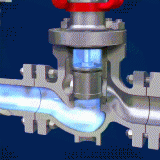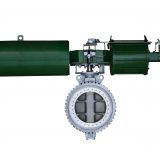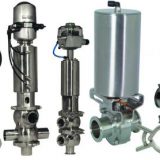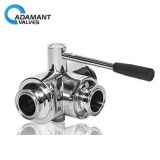Many valves can adapt to a variety of working conditions, but if the choice is not reasonable, the performance and service life of the valve will be greatly reduced. To select valves correctly and reasonably, first of all, we need to understand the working conditions of the materials of various parts of the valves. There are many materials for manufacturing sanitary valve parts, including ferrous metals and non-ferrous metals of different brands, their alloys and various non-metallic materials. Understand the material and choose according to the different scope of use so as to make the best performance.
Materials for making valve parts shall be selected according to the following factors:
1. The pressure, temperature, and characteristics of the working medium.
2. The force of the part and its function in the valve structure.
3. It has better technology.
4, in meeting the above conditions, there must be a lower cost.
The materials of the valve body, bonnet, and valve plate
Valve body, valve cover, and gate (disc) are the main parts of the valve. They bear medium pressure directly. The material must meet the requirements of “pressure and temperature grade of the valve”. The following materials are:
One, Gray iron:
Gray cast iron is suitable for media such as water, steam, air, gas, and oil, whose nominal pressure PN is less than 1.0 MPa and temperature is -10 ~200 ~C. Common grey iron grades are HT200, HT250, HT300, and HT350.
Two, Malleable iron:
It is suitable for water, steam, air and oil media whose nominal pressure PN is less than 2.5 MPa and temperature is -30-300 C. The commonly used brands are KTH300-06, KTH330-08, and KTH350-10.
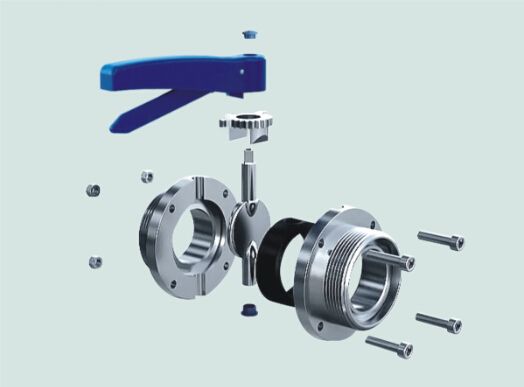
Three, Ductile iron:
It is suitable for PN, 4.0MPa, water, steam, air and oil medium with a temperature of 30~350 degrees. Commonly used brands are QT400 – 15, QT450 – 10, QT500 – 7. According to experience, it is suggested that PN should be less than 2.5MPa, and valves should be made of steel valves.
Four, acid resistant high silicon nodular cast iron:
It is suitable for the corrosive medium with the nominal pressure of PN or less than 120 0.25MPa.
Five, Carbon steel:
It is suitable for media such as water, steam, air, hydrogen, ammonia, nitrogen and petroleum products whose nominal pressure PN is less than 32.0 MPa and temperature is -30-425 C. Commonly used brands are WC1, WCB, ZG25 and high-quality steel 20, 25, 30 and low alloy structural steel 16Mn.
Six, copper alloy:
It is suitable for water, seawater, oxygen, air, oil and other media with PN < 2.5 MPa, as well as stream media with temperature – 40-250 C. The commonly used brands, are ZGnSn10Zn2 (tin bronze), H62, Hpb59-1 (brass), QAZ19-2, QA19-4 (aluminum bronze).
Seven, High-temperature copper:
It is suitable for steam and petroleum products whose nominal pressure is PN or less than 17.0MPA, and the temperature is less than 570 degrees. Common brands are ZGCr5Mo, 1Cr5M0. ZG20CrMoV, ZG15Gr1Mo1V, 12CrMoV, WC6, WC9 and so on. Specific selection must be in accordance with the regulation of valve pressure and temperature.
Eight, Low-temperature steel:
Suitable for nominal pressure PN < 6.4Mpa, temperature (>196 C) ethylene, propylene, liquid natural gas, liquid nitrogen, and other media, commonly used brands) ZG1Cr18Ni9, 0Cr18Ni9, 1Cr18Ni9Ti, ZG0Cr18Ni9.
Nine, stainless acid resistant steel:
It is suitable for media such as nitric acid and acetic acid with nominal pressure PN < 6.4Mpa, temperature < 200 C. The commonly used brands are ZG0Cr18Ni9Ti, ZG0Cr18Ni10 < nitric acid resistance >, ZG0Cr18Ni12Mo2Ti, ZG118Ni12Mo2Ti < acid resistance and urea resistance >.
The relationship between valve material and temperature
Sealing surface material
The sealing surface is the most critical working face of the valve. The quality of the sealing surface is related to the service life of the valve. Usually, the sealing surface materials should consider corrosion resistance, abrasion resistance, erosion resistance, oxidation resistance and other factors.
There are usually two broad categories.
(1) Soft materials:
1, Rubber (including butadiene rubber, fluorine rubber, etc.)
2, Plastics (polytetrafluoroethylene, nylon, etc.)
(2) Hard sealing material:
1, Copper alloy (for low-pressure valves)
2. Chrome stainless steel (for ordinary high and medium pressure valves)
3. Stellite alloy (for high temperature and high-pressure valves and strong corrosion valves)
4. Nickel based alloys (for corrosive media)
Stem material
During the opening and closing of the valve, the valve stem bears tension, pressure and torsion forces, and contacts with the medium directly. At the same time, there is a relative friction movement between the valve stem and the filler. Therefore, the material of the valve stem must ensure sufficient strength and impact toughness at the specified temperature, with certain corrosion resistance and scratch resistance, as well as good performance.
One, Carbon steel
A5 common carbon steel is generally used in water and steam medium with low pressure and medium temperature not exceeding 300 C.
When used in medium pressure and medium temperature not exceeding 450 C for water and steam medium, 35 high-quality carbon steel is generally selected.
Two, Alloy steel
40Cr (chromium steel) is generally used in medium pressure and high-pressure media, such as water, steam, and petroleum, where the medium temperature does not exceed 450 C.
38CrMoALA nitriding steel can be used in high pressure and medium temperature not exceeding 540 for water, steam, and other media.
25Cr2MoVA chromium molybdenum vanadium steel is widely used in steam medium with high temperature and medium temperature not exceeding 570 C.
Three, stainless acid resistant steel
For medium and high-pressure non-corrosive medium and weak corrosive medium with the medium temperature not exceeding 450 C, 1Cr13, 2Cr13, and 3Cr13 stainless steel can be selected.
When used in corrosive medium, stainless acid-resistant steel such as Cr17Ni2, 1Cr18Ni9Ti, Cr18Ni12Mo2Ti, Cr18Ni12Mo3Ti and precipitation hardening steel PH15-7Mo can be selected.
Four, Heat resistant steel
4Cr10Si2Mo martensitic heat resistant steel and 4Cr14Ni14W2Mo austenitic heat resistant steel can be used for high-temperature valves with the medium temperature not exceeding 600 C.
For more information, please visit http://www.adamantvalves.com/
